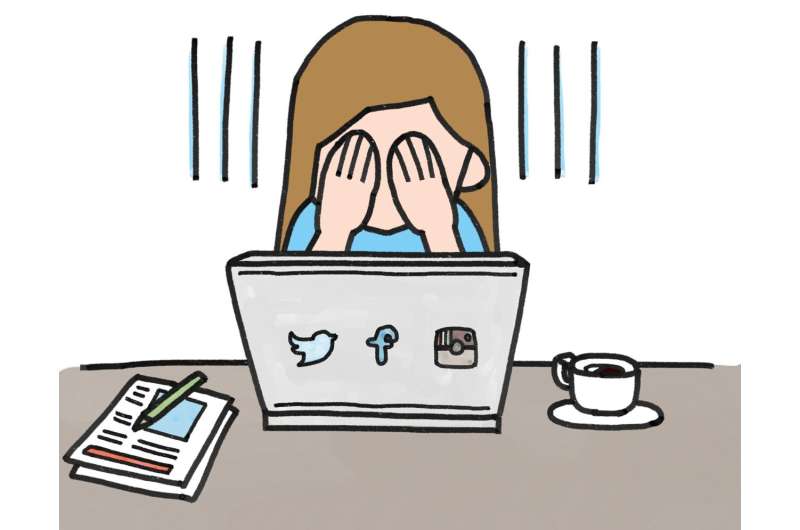Turning a blind eye to image-based abuse

Image-based abuse, also commonly known as "revenge pornography" involves three main behaviors—non-consensually taking or creating nude or sexual images, threatening to share or distribute nude or sexual images, and non-consensually sharing or distributing nude or sexual images.
As many as one in three people across Australia, the U.K., and New Zealand (aged 16 to 64) have experienced image-based abuse, which can have a range of harmful psychological and social impacts on victims.
Support and intervention provided by bystanders—that is, people who witness abusive behaviors—can reduce the occurrence and impacts of image-based abuse.
Research among a sample of 6,109 respondents from Australia, New Zealand, and the U.K. found that only 46% of people who had ever witnessed image-based abuse had intervened.
We've conducted a study exploring Australians' attitudes towards, and awareness of, image-based abuse, their willingness to intervene as bystanders when witnessing image-based abuse, and the factors that may facilitate or hinder them from saying or doing something in response to image-based abuse.
Our study included surveys with 245 Australians (aged 18 to 71) and 35 focus groups with a subset of 219 participants from New South Wales, Victoria, South Australia and the Australian Capital Territory.
Do people intervene when witnessing image-based abuse?
About two-thirds (64%) of our survey respondents reported that they had witnessed image-based abuse, which typically involved a male perpetrator and a female victim. Most people felt uncomfortable about witnessing the abuse and felt sorry for the victim.
However, only 46% of those who had witnessed image-based abuse indicated they had said or done something in response.
The actions that were most commonly reported were to confront the perpetrator (56%); tell a friend, family member, or colleague (50%); and support the victim (47%).
It was uncommon for respondents to say they had reported the perpetrator to the police or another official (15%), or reported them to an online platform or provider (7%).
Why people do intervene
Among those who did say or do something when witnessing image-based abuse, they said the reasons they had done so were because the abuse is wrong, because intervening was the right thing to do, or because the abuse is illegal.
Our focus group findings revealed that participants were more likely to intervene if the victim or perpetrator was a close friend or if they perceived that they would be supported by other bystanders.
For instance, if the perpetrator was a close friend, participants said that they would feel able to confront them and tell them that the behavior was wrong.
Why people don't intervene
Although bystander intervention could reduce the occurrence and impacts of image-based abuse, it's apparent from our research findings that there's a range of barriers that may hinder people from intervening.
Among the survey respondents, the main reasons given for not intervening were because they didn't feel comfortable, or didn't feel it was their responsibility to say or do something.
The focus groups similarly revealed a range of barriers that hindered participants from saying or doing something when witnessing image-based abuse.
Some participants said that if the perpetrator was not a close friend and there were other people present, they would view it as the responsibility of others to intervene. Others were also concerned about the social implications of intervention, such as the reactions of others, and the concern that they wouldn't be supported by other bystanders.
Risk to personal safety was also a key barrier to intervention, such as in circumstances where the perpetrator was physically intimidating, or where intervention might result in backlash from the perpetrator or from others either to themselves or to others.
Gender also played a key role, with women more likely to report that they might not feel safe or comfortable to intervene, particularly if the perpetrator was a man, or they didn't have the support of others to intervene.
We need more awareness on appropriate intervention responses
Bystander intervention programs are those that encourage people to intervene when witnessing the warning signs for various forms of harm, such as image-based abuse.
These programs help to empower individuals to be able to identify a situation as abusive, to build skills and confidence to intervene, as well as increasing knowledge around strategies for intervening safely.
Research has found that these programs have beneficial outcomes in increasing awareness of, and responsibility to prevent, sexual violence, including interventions among adolescents and higher-degree students who may be of the age group that are more likely to engage in, or witness, image-based abuse.
However, there's an urgent need for the development of bystander intervention programs specific to image-based abuse, and for further research to evaluate the effectiveness of these programs.
Ultimately, bystander intervention programs that increase the confidence and skills of people to safely intervene must be incorporated into our broader response to prevent and respond to image-based abuse.
More information: Preventing image-based abuse in Australia: The role of bystanders. www.aic.gov.au/crg/reports/crg-0218-19
Provided by Monash University




















